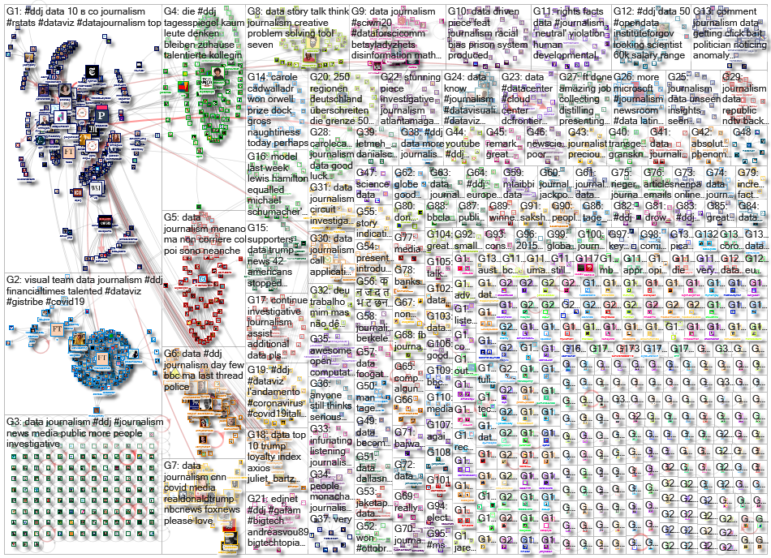
Image: Der Tagesspiegel
Gearing up for Halloween? You’ll want to refer to our NodeXL #ddj mapping from October 19 to 25. We found FiveThirtyEight’s ultimate Halloween candy ranking from the archives to please the palates of finicky trick-or-treaters. This edition also includes The Economist’s mathematical model to determine whether Formula 1 racing success depends on driver or engineer; The Globe and Mail examines bias in Canada’s prison system; and El Pais looks at how to reduce COVID-19 transmissions indoors.
The Ultimate Halloween Candy Power Ranking
An oldie but goodie to help you prepare the right munchies for this year’s Halloween: FiveThirtyEight surveyed over 8,000 people in 2017 to find out which fun-sized Halloween candy is the most preferred choice and analyzed the ingredients that likely contributed to its popularity. Reese’s Peanut Butter Cup comes out on top and will most likely endear you to trick-or-treaters.
This is making the rounds again but it remains as accurate as it was 3 years ago. https://t.co/U3BaTUn8PV pic.twitter.com/b3FU1YFkcP
— Ruth Igielnik (@RuthIgielnik) October 19, 2020
Secrets of Formula 1 Success
Are race car drivers or the engineers behind their cars the true determinant of success in motor sports? The Economist built a mathematical model, based on a study by Andrew Bell at the University of Sheffield, to measure the impact of all 745 race car drivers in Formula 1 history and find out how much credit should go to the driver or the engineer.
Last week Lewis Hamilton equalled Michael Schumacher's record of 91 Formula 1 GP victories. But who is the best driver to have ever gotten behind the wheel? #datadrivenjournalism #ddj #formula1https://t.co/yQsD79gr4A
— James Fransham (@JamesFransham) October 21, 2020
Canada’s Biased Prison System
The Correctional Service of Canada uses several risk assessments to place, treat, and release inmates. Two key assessments are: the Custody Rating Scale to measure the security risk an inmate poses, which affects how many restrictions are imposed on him or her; and the Reintegration Potential Score, which influences an inmate’s chances of parole or early release. To find out how race could affect the authorities’ treatment of a prisoner, Canada’s Globe and Mail spoke with more than 60 inmates, lawyers, psychologists, academics, and correctional officers; reviewed dozens of academic studies on risk assessments; and read hundreds of pages of correctional files. It discovered that the risk assessments were fundamentally and powerfully biased against Indigenous and Black inmates. Read the methodology for this investigation and the backstory.
I've been hearing this from numerous inmates and lawyers, but the Globe proves it: Our prison classification system is racist. A really incredible piece of journalism. @tom_cardoso https://t.co/3A73vgk33J
— Justin Ling (@Justin_Ling) October 26, 2020
Reducing COVID-19 Transmission Indoors
How does COVID-19 transmit indoors? And how can we tackle it? El Pais, a Spanish daily, visualized three different scenarios — a living room, a bar, and a classroom — in which people might get infected by the coronavirus. It also explained how the probability of infection could be reduced through proper ventilation, usage of masks, and shortening the duration of person-to-person encounters. (In Spanish.) Read the story in English here.
At home, in a bar/cafe, in the classroom. How #COVID19 spreads indoors and how to reduce contagion risk. #Masks and ventilation key.
Very informative from #ElPais. More of this practical information on what to do, not just what’s allowed or not. https://t.co/LGlVP6hxXT
— Marta Foresti (@martaforesti) October 26, 2020
A COVID-19 Dashboard Disaster
Who was behind a faulty COVID-19 dashboard presented by the Georgia Department of Public Health in the United States? In this Atlanta Magazine long read, journalist Keren Landman dove into a trove of emails discussing the problems and discovered that the department had limited input into, and no real oversight of, the dashboard.
In an exceptional long read, @AtlantaMagazine unpacks the 'why' behind the GA COVID dashboard issues.
The saga of vendors, unfixed errors, and a sidelined DPH is a fierce reminder of why #COVID19 #dataviz designers should listen to public health experts. https://t.co/xlOGoMgkUI
— Amanda Makulec MPH (@abmakulec) October 26, 2020
Berlin Airport Delay in 3D
The Berlin Brandenburg Airport is expected to open to the public this Saturday, October 31, a total of 14 years after its groundbreaking, and after a nine-year postponement from its initial planned launch date in 2011. German daily Der Tagesspiegel created an 3D interactive model of the airport to explain the structural fiascos that contributed to the delay. (In German.)
Why did the Berlin region's new international airport #BER take 14 years to build, come in wildly overbudget & see its opening delayed by 9 years? @Tagesspiegel breaks down the "laughing stock"'s woes in excruciating (fascinating) detail w/this graphic https://t.co/jtydbg2KES
— Deborah Cole (@doberah) October 20, 2020
Five Charts on Colorado’s Wildfires
The 2020 fire season has been historic in Colorado with the Pine Gulch fire — which burned around 139,000 acres — becoming the largest fire in recorded state history this summer. The Cameron Peak fire, which ignited in August, then smashed that record by burning over 208,000 acres. The Colorado Sun presented Colorado’s wildfire history since the year 2000 in five charts.
When we published this graphic about large #Colorado #wildfires two days ago we didn't think 2020 was going to be the biggest fire year on record. Fast forward and today, it has eclipsed the acreage burned in the last five years combined. @johningold https://t.co/BYFv0MRIyR
— Dana ☀️ Coffield (@danacoffield) October 22, 2020
German Mobility Jumps Back
This autumn in Germany, people are as mobile as ever compared to last year even though the number of COVID-19 cases is rising rapidly. Der Tagesspiegel analyzed anonymized mobile phone data from Teralytics and traffic data from TomTom to determine the mobility of people and found that people were traveling more to rural vacation regions and spending more time in cars. (In German.)
As Germany considers new lockdown measures, our collaboration with @Tagesspiegel shows that #mobility is back to pre-pandemic levels. How people #travel has changed, however, with road #traffic surging.https://t.co/Q4MEYunFBp
— Teralytics (@teralytics) October 26, 2020
Global Data Journalism Practices
Information scientist and data journalism professor Bahareh Heravi and Datawrapper co-founder Mirko Lorenz conducted a Global Data Journalism survey from December 2016 to May 2017 to study data journalism practices in newsrooms. In this article, they summarize the results of their study, which covers the configuration of data teams, the hurdles of carrying out data journalism, and the journalists’ self-assessed knowledge of the field.
We invite you to read our latest article "Data Journalism Practices Globally: Skills, Education, Opportunities, and Values" by @Bahareh360 and @mirkolorenz
Full article 👇https://t.co/UFMXye8KnJ#datajournalism #ddj #Newsroom #computationaljournalism pic.twitter.com/QDlekgf9LD
— Journalism and Media (@JourMedia_MDPI) October 22, 2020
Cancelling Serious Crime Reports
The BBC Shared Data Unit examined reports from the inspections of 43 police forces in England and Wales. It found that at least 19 forces had wrongly canceled reports of rape, 38 forces incorrectly canceled at least one record of a sexual offense, and in many cases, victims had not been informed that their cases were being dropped.
UK police forces wrongly cancelled reports of serious crimes https://t.co/Ftf3isx19V
— Prof. Phil Rumney (@phil_rumney) October 23, 2020
Thanks again to Marc Smith and Harald Meier of Connected Action for gathering the links and graphing them. The Top Ten #ddj list is curated weekly.
 Eunice Au is GIJN’s program manager. Previously, she was a Malaysia correspondent for Singapore’s The Straits Times, and a journalist at the New Straits Times. She has also written for The Sun, Malaysian Today, and Madam Chair.
Eunice Au is GIJN’s program manager. Previously, she was a Malaysia correspondent for Singapore’s The Straits Times, and a journalist at the New Straits Times. She has also written for The Sun, Malaysian Today, and Madam Chair.

